Our Sanctuary and Annex
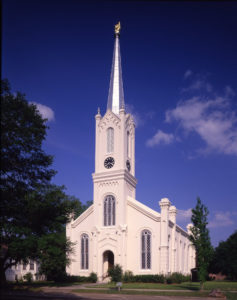
On July 5, 1942, the Reverend Alfred N. Moffett issued this greeting: “This church is a gift to this generation by the religious pioneers of the past. It is a noble reflection of their faith in God, and in us! It cost them tens of thousands of dollars. It is our privilege to use it, keep it in repair, make it meaningful to our generation, and support it with our love and loyalty.”
Although the congregation was originally organized as the Bayou Pierre Presbyterian Church a few miles west of town in 1807, Dr. Zebulon Butler , a native of Wilkesbarre, Pennsylvania, was the first pastor to serve the First Presbyterian Church after the congregation moved to Port Gibson. He led them in a building program for the first house of worship on this site, which was constructed between the years 1829 and 1831. It was also made of brick, but was much smaller.
By 1859, the congregation numbered 160, and they decided to build the present structure. But because of threats of war, the northern contractor only completed the walls up to the parapet. Elder H.N. Spencer took over the project, and lent the congregation $8,000 to complete it, a debt which he forgave in his will.
The Sanctuary was dedicated to the worship of God on December 16, 1860. The Rev. Dr. W.L. Breckenridge, President of Oakland College had to preach the dedicatory sermon due to the illness of Dr. Butler, who died on the 23rd of the same month.
The congregation built this building with a vision of growth. T he room measures 66 feet from front to rear, 49 feet from side to side, and 36 feet from t he floor to the center of the vaulted ceiling. The shape of the ceiling provides a perfect acoustic environment for well over 400 people to hear a speaker without any need for electrical amplification.
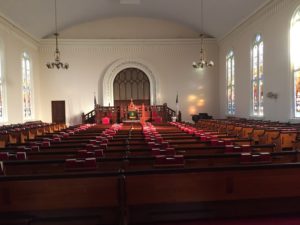
The decorative plaster work, including the brackets underneath the balcony, the moldings around the windows, and the beautiful arch behind the pulpit, is attributed to the artistic genius of William English.
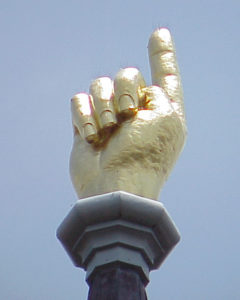 “The Hand pointing to Heaven” is the unique feature of this Romanesque Revival style edifice. The first hand was carved from wood by Daniel Foley, a young local craftsman. The ravages of time, however, destroyed it; and around 1901 the present hand was commissioned and installed. It was taken down in 1989 to be repaired and replated. It was raised again in 1990 and placed atop a newly re-enforced steeple.
“The Hand pointing to Heaven” is the unique feature of this Romanesque Revival style edifice. The first hand was carved from wood by Daniel Foley, a young local craftsman. The ravages of time, however, destroyed it; and around 1901 the present hand was commissioned and installed. It was taken down in 1989 to be repaired and replated. It was raised again in 1990 and placed atop a newly re-enforced steeple.
The distance from the sidewalk to the tip of the finger measures 147 feet. The hand is ten feet, four inches tall and the index finger is four feet long. Fabricated from 24 gauge sheet iron, the hand weighs 200 pounds, and is covered by the finest German gold leaf which is but .0003 of an inch thick – ten times thinner than a sheet of paper.
The clock is original to the building. It was manufactured by Sperry & Co. of New York and cost $500 at the time. It features a mechanism that strikes the bell on the hour.
The town of Port Gibson originally contributed $200 to the price of the clock because the time piece served the whole town. In 1946 the town deeded its interest in the clock to the church for one dollar. It was electrified in 1952 by the Tower Clock Company . The clock was completely disassembled, cleaned, repaired, and reassembled in 2003.
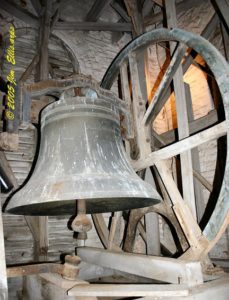 The bell was cast by Meneelys’ of West Troy, New York. It weighs 2032 pounds, just 48 pounds lighter than the Liberty Bell in Philadelphia, Pennsylvania. Tradition has it that $500 in silver coin was given to be melted into the metal of the bell to improve its tone. After selling the old bell for $300, the remainder of the price of the new bell was paid by Elder H.N. Spencer. It was first rung on October 10, 1860.
The bell was cast by Meneelys’ of West Troy, New York. It weighs 2032 pounds, just 48 pounds lighter than the Liberty Bell in Philadelphia, Pennsylvania. Tradition has it that $500 in silver coin was given to be melted into the metal of the bell to improve its tone. After selling the old bell for $300, the remainder of the price of the new bell was paid by Elder H.N. Spencer. It was first rung on October 10, 1860.
When the building was completed at a cost of approximately $40,000, all funds were exhausted. To furnish the interior, the pews were auctioned to members. Descendants of many of these members occupy those same pews each Lord’s Day. At first arranged with a center aisle, in 1879 the center pews were joined, resulting in their present appearance.
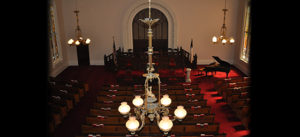 The chandeliers of solid brass are from the famous old steamboat Robert E. Lee and were a gift to the church from Mr. and Mrs. William Parker. Originally designed to burn kerosene, they are now electrified.
The chandeliers of solid brass are from the famous old steamboat Robert E. Lee and were a gift to the church from Mr. and Mrs. William Parker. Originally designed to burn kerosene, they are now electrified.
In 1903, the beautiful stained glass windows were installed at a total cost of $888.00. They were restored and reinstalled in 1990 at a cost of $12,000. The windows in the front of the building are original, and feature “ flash ” type glass.
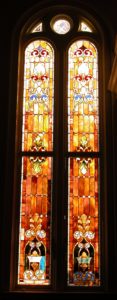 The organ is a nine rank instrument designed and built by Henry Pilcher’s Sons of Louisville, Kentucky in 1930. The cost of the organ was $4,600.00, excluding work performed on the sanctuary to house it. The organ was completely restored in 2011 through the generosity and efforts of Richard Ahlvin and Bob Garner.
The organ is a nine rank instrument designed and built by Henry Pilcher’s Sons of Louisville, Kentucky in 1930. The cost of the organ was $4,600.00, excluding work performed on the sanctuary to house it. The organ was completely restored in 2011 through the generosity and efforts of Richard Ahlvin and Bob Garner.
By 1959, the sanctuary was in great need of restoration. The south stair had been removed and the vestibule and balcony had been partitioned for offices and classrooms. Much of the plaster work was cracked or falling. That year, the interior of the building was completely restored, at a cost of nearly $80,000.
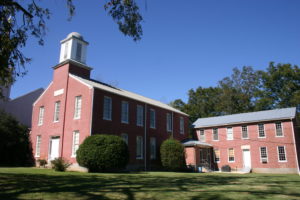 To the rear of the sanctuary is a two-story brick building erected in 1857 as Brashear Academy, a finishing school for young ladies. The lot on which it stands was donated by the church for school purposes with the provision that, in the event it ceased to be so used, it should revert to the church. In addition to Brashear Academy, the building served Chamberlain-Hunt Academy from 1879 until 1900 and the local public school from 1903 until 1925. In 1925 the property reverted to the church and extensive repairs were made through the generosity of Mr. and Mrs. Carl Blomquist. Today “ The Annex ” serves this church as an educational plant and fellowship hall.
To the rear of the sanctuary is a two-story brick building erected in 1857 as Brashear Academy, a finishing school for young ladies. The lot on which it stands was donated by the church for school purposes with the provision that, in the event it ceased to be so used, it should revert to the church. In addition to Brashear Academy, the building served Chamberlain-Hunt Academy from 1879 until 1900 and the local public school from 1903 until 1925. In 1925 the property reverted to the church and extensive repairs were made through the generosity of Mr. and Mrs. Carl Blomquist. Today “ The Annex ” serves this church as an educational plant and fellowship hall.
We praise God for His faithfulness to this congregation over so many years. He has blessed us with a rich heritage, but it is not our desire to become a museum to house the things of the past. Instead, God calls this generation to the same work our ancestors have done since 1807: to proclaim to the world that, by His free grace, God saves sinners through faith alone in Christ alone. Our hearts’ desire is that people would not simply gaze upon our steeple, with its hand pointing to heaven, but instead lift their eyes to the transcendent God to Whom it points.



